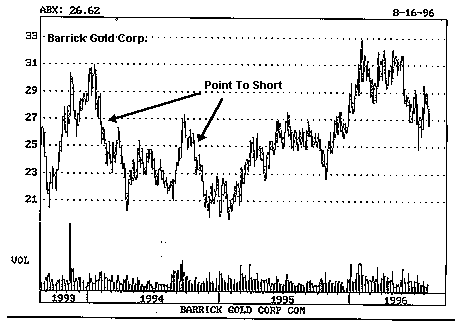
Playing the short side of the stock market is not for everyone. But, for those who wish to venture about as bears, there are some important guidelines that if followed can be rewarding.
In the classic book "Reminiscences of a Stock Operator," the author gives this extremely important advice for shorting: "Always bear in mind (a pun?) that one should never try to sell short at the top. It isn't wise. Instead, try to sell short after a reaction if there is no rally."
Sometimes when one is bearish and looking for a good short, the tendency is to be too anxious. One bearish analyst said, "I am a bear, but I don't want to get slaughtered before the top."
When trying to go short look first at the technical setup of a stock that has risen. What you want to see is the price rising, then pulling back and then failing to be able to rally with the market. The short can be executed off the breakdown from the reaction low.
Taking a look of the chart of Barrick Gold Corp. (ABX) we can see this popular gold stock moved up to 27 1/4 in September 1994 and then pulled back to 25 in what appeared to be a normal reaction.

But, then ABX broke down under support in late October and went into a bear phase declining to 20 during the next seven weeks to produce a nice gain for a smart bear who could time this trading play. The same bearish pattern occurred in early 1994.
It is important to wait for the rally failure after the peak. An accumulation-distribution indicator such as TTD's tick volume study can be used to confirm where unusual selling is taking place.
When shorting, one should place a stop buy so as to be able to exit a position if it moves against you.
Also, the volatility of the individual stock should be taken into consideration when placing a protective stop buy. For example a heavily traded blue chip stock like General Electric Co. (GE) may not fluctuate as wildly as say a Sybase Inc. (SYBS). So, a bear could place a stop on GE a bit tighter, where as he might need to give Sybase more room to "vibrate."
In our example, Barrick Gold had a beta of 0.33, which means it's less volatile than the S&P 500 index which would be rated 1.0. So, a protective stop buy could have been placed tight say at 27 in October. The Beta of a stock can be found in research chart books like those published by "Daily Graphs" of Los Angeles.
Shorting a stock when the market is heading lower increases a bears chances to make a successful trade. But there in lies a subtle nuisances that trips up the novice investor.
In most cases, a market does not culminate in one grand blaze of glory or a sudden reversal flash. A market can and often does cease to be a bull market long before the averages begin to decline.
What happens is that the leading stocks of the bull market will decline to reaction lows and then fail to rally. However, the rest of the market will advance and new stocks will begin to lead. To the casual observer, it will appear that the bull market is back in force.
Not so, exactly. Money can still be made on the longside but the number of stocks rising will become less and less and the quality of those stocks will be lower. Also, stocks will get "cratered" if profits should disappoint. Eventually, the "new leaders" will begin to fail and the market will roll over and go down.
A good way for investors to have a better understanding of how the leaders are doing is to make a list of about 15 stocks, NYSE and OTC, that have a high Relative Strength and Earnings Per Share rank as measured by Investors Business Daily.
Watch those 15 stocks closely to see how they are acting. These stocks would be your bull market leaders and the index developed from them is sometimes referred to as a "swing index."
If the swing index breaks below its uptrend and then fails to rally, it will be a good sign that the general market will be ready to tank soon. So, aggressive bears should get ready to act.